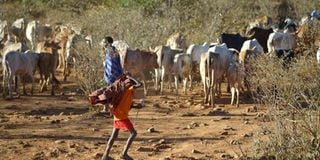Samburu in tough times as drought hits hard

Young Samburu boys herd their family’s livestock on January 24, 2017.
Officials in Samburu County have issued a hunger alert due to a prolonged drought that has ravaged the area.
Women, children and the elderly are the most affected, with many walking long distances in search of food, water and pasture for their livestock.
Wamba, Archers Post, Baragoi, South Horr, Barsaloi, Suyian, Loonjorin, Opiroi and Nachola are all hard hit. In some areas, desperate families have been waking up as early as 4am to sit on roadsides begging for water from motorists. Throughout the day, they endure the scorching sun. National Drought Management Authority (NDMA) County Coordinator Alex Leseketet said the dry spell, particularly in Samburu East and Samburu North, has seen livestock numbers dwindle and their market value deteriorate.
“The situation is getting worse. Pastoralists have been hit by water shortages and pastures have been exhausted,” Mr Leseketet told Nation, adding that an estimated 50,000 people have been affected. NDMA has now issued a drought alert and called for urgent intervention.
Mr Leseketet said locals have started moving out in a bid to quench their animals’ thirst. Pastoralists in Marsabit, Isiolo, Baringo and Turkana counties have been forced to travel several kilometres amid escalating tension and insecurity due to competition over dwindling feeding grounds. There is concern that the situation may spark conflicts as groups scramble for the scarce resources.
Grazing areas
“Herders have moved to dry season grazing areas. We have also established that a decline was recorded in milk production and consumption at household levels,” Leseketet said.
Data from NDMA also shows severely malnourished children stand at 0.2 percent while 26.7 percent are moderately malnourished. Some families are relying on camel milk for survival.
A massive humanitarian intervention is needed to address the situation, according to Special Programmes Chief Officer Daniel Lesaigor. Thousands are in serious humanitarian need, battling the Covid-19 pandemic, the desert locusts invasion and the prolonged drought.
“We have developed a multi-hazard contingency plan because of the emergency,” Mr Lesaigor said.
The triple challenges are threatening food security, and increasing competition for pasture and fuelling conflicts, according to Mr Lesaigor.





